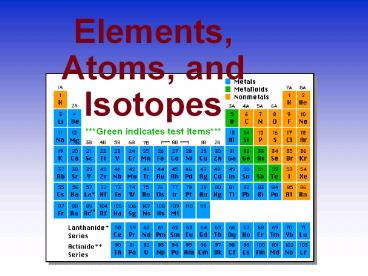Elements, Atoms, and Isotopes - PowerPoint PPT Presentation
1 / 25
Title:
Elements, Atoms, and Isotopes
Description:
Title: Atoms, Elements, and Ions Subject: Chemistry I (High School) Author: Neil Rapp Keywords: atoms, ions, elements, protons, neutrons, electrons, isotopes – PowerPoint PPT presentation
Number of Views:155
Avg rating:3.0/5.0
Title: Elements, Atoms, and Isotopes
1
- Elements, Atoms, and Isotopes
- Green indicates test items
2
The Language of Chemistry
- CHEMICAL ELEMENTS -
- pure substances that cannot be decomposed by
ordinary means to other substances.
Aluminum
Bromine
Sodium
3
The Language of Chemistry
- The elements, their names, and symbols are given
on the PERIODIC TABLE - How many elements are there?
4
The Atom
- An atom consists of a
- nucleus
- (of protons and neutrons)
- electrons in space around the nucleus.
5
Copper atoms on silica surface.
- An _____ is the smallest particle of an element
that has the chemical properties of the element.
Distance across 1.8 nanometer (1.8 x 10-9 m)
6
Subatomic Particles
- Quarks
- component of protons neutrons
- 6 types
- 3 quarks 1 proton or 1 neutron
7
The red compound is composed of nickel (Ni)
(silver) carbon (C) (black) hydrogen (H)
(white) oxygen (O) (red) nitrogen (N)
(blue)
- CHEMICAL COMPOUNDS are composed of atoms and so
can be decomposed to those atoms.
8
Compounds
- composed of 2 or more elements in a fixed ratio
- properties differ from those of individual
elements - EX table salt (NaCl)
9
A MOLECULE is the smallest unit of a compound
that retains the chemical characteristics of the
compound.
- Composition of molecules is given by a MOLECULAR
FORMULA
C8H10N4O2 - caffeine
H2O
10
ATOM COMPOSITION
The atom is mostly empty space
- protons and neutrons in the nucleus.
- the number of electrons is equal to the number of
protons. - electrons in space around the nucleus.
- extremely small. One teaspoon of water has 3
times as many atoms as the Atlantic Ocean has
teaspoons of water.
11
ATOMIC COMPOSITION
- Protons (p)
- positive electrical charge
- mass 1.672623 x 10-24 g
- relative mass 1.007 atomic mass units
(amu) but we can round to 1 - Electrons (e-)
- negative electrical charge
- relative mass 0.0005 amu
but we can round to 0 - Neutrons (no)
- no electrical charge
- mass 1.009 amu but we can round to 1
12
Atomic Number, Z
- All atoms of the same element have the same
number of protons in the nucleus, Z
13
Al
26.981
13
Mass Number, A
- C atom with 6 protons and 6 neutrons is the mass
standard - 12 atomic mass units
- Mass Number (A) protons neutrons
- NOT on the periodic table(it is the AVERAGE
atomic mass on the table) - A boron atom can have A 5 p 5 n
10 amu
14
Isotopes
- Atoms of the same element (same Z) but different
mass number (A). - Boron-10 (10B) has 5 p and 5 n
- Boron-11 (11B) has 5 p and 6 n
15
Figure 3.10 Two isotopes of sodium.
16
Isotopes Their Uses
Bone scans with radioactive technetium-99.
17
Isotopes Their Uses
The tritium content of ground water is used to
discover the source of the water, for example, in
municipal water or the source of the steam from a
volcano.
18
Atomic Symbols
- Show the name of the element, a hyphen, and the
mass number in hyphen notation - sodium-23
- Show the mass number and atomic number in nuclear
symbol form - mass number
- 23 Na
- atomic number 11
19
Isotopes?
- Which of the following represent isotopes of the
same element? Which element? - 234 X 234 X 235 X 238 X
- 92 93 92 92
20
Counting Protons, Neutrons, and Electrons
- Protons Atomic Number (from periodic table)
- Neutrons Mass Number minus the number of protons
(mass number is protons and neutrons because the
mass of electrons is negligible) - Electrons
- If its an atom, the protons and electrons must
be the SAME so that it is has a net charge of
zero (equal numbers of and -) - If it does NOT have an equal number of electrons,
it is not an atom, it is an ION. For each
negative charge, add an extra electron. For each
positive charge, subtract an electron (Dont add
a proton!!! That changes the element!)
21
Learning Check Counting
- Naturally occurring carbon consists of three
isotopes, 12C, 13C, and 14C. State the number of
protons, neutrons, and electrons in each of these
carbon atoms. - 12C 13C 14C
- 6 6
6 - p _______ _______
_______ - no _______ _______
_______ - e- _______ _______
_______
22
Answers
- 12C 13C 14C
- 6 6
6 - p 6 6 6
- no 6 7 8
- e- 6 6 6
23
Learning Check
- An atom has 14 protons and 20 neutrons.
- A. Its atomic number is
- 1) 14 2) 16 3) 34
- B. Its mass number is
- 1) 14 2) 16 3) 34
- C. The element is
- 1) Si 2) Ca 3) Se
- D. Another isotope of this element is
- 1) 34X 2) 34X 3) 36X
- 16 14
14
24
AVERAGE ATOMIC MASS
- Because of the existence of isotopes, the mass of
a collection of atoms has an average value. - Boron is 20 10B and 80 11B. That is, 11B is 80
percent abundant on earth. - For boron atomic weight
- 0.20 (10 amu) 0.80 (11 amu) 10.8 amu
25
Isotopes Average Atomic Mass
- Because of the existence of isotopes, the mass of
a collection of atoms has an average value. - 6Li 7.5 abundant and 7Li 92.5
- Avg. Atomic mass of Li ______________
- 28Si 92.23, 29Si 4.67, 30Si 3.10
- Avg. Atomic mass of Si ______________































